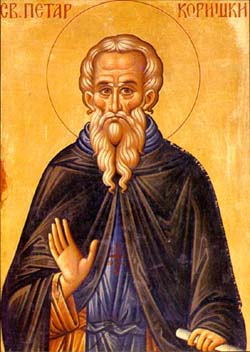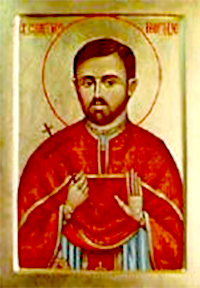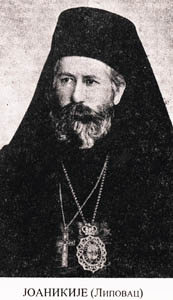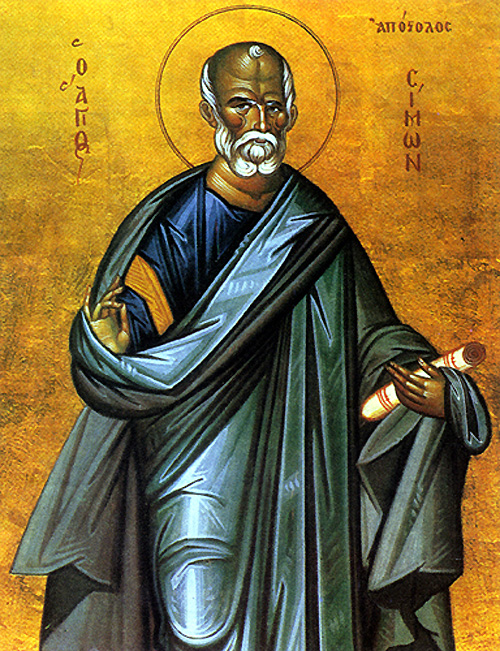The Life of Our Blessed Father Peter of Korisha
 SAINT PETER'S HEROIC struggles recall the spiritual labours of Saint Anthony the Great and the monks of theEgyptian desert. This unseen and inner warfare is not confined to monks alone. From the moment of our baptism, all Orthodox Christians are called to fight the varied lusts and passions of the flesh and to oppose the evil demons who ceaselessly rage against us day and night. As the Apostle Paul says, For we wrestle not against flesh and blood but against principalities, against powers, against the rulers of the darkness of this world, against spiritual wickedness in high places (Eph. 6:12).
SAINT PETER'S HEROIC struggles recall the spiritual labours of Saint Anthony the Great and the monks of theEgyptian desert. This unseen and inner warfare is not confined to monks alone. From the moment of our baptism, all Orthodox Christians are called to fight the varied lusts and passions of the flesh and to oppose the evil demons who ceaselessly rage against us day and night. As the Apostle Paul says, For we wrestle not against flesh and blood but against principalities, against powers, against the rulers of the darkness of this world, against spiritual wickedness in high places (Eph. 6:12).
May Orthodox Christians find in Saint Peter of Korisha a powerful intercessor before God in their spiritual warfare. He is a ready helper for those distressed in body, soul and spirit by the pressures, tensions and demands of living in these last days of general unbelief in God.
St. Hieromartyr Djordje Bogic
 Hieromartyr Georgije - Djordje Bogic, Parish Priest of Nasice Djordje was born in Pakrac on February 6, 1911. He completed lowergrade Grammar school in Nova Gradiska, and the Seminary in Sarajevo.
Hieromartyr Georgije - Djordje Bogic, Parish Priest of Nasice Djordje was born in Pakrac on February 6, 1911. He completed lowergrade Grammar school in Nova Gradiska, and the Seminary in Sarajevo.
On May 25, 1934, Djordje was ordained in Pakrac. Djordje had performed his duties in the parishes of Majar and Bolmace, wherefrom he was moved to Nasice where he happened to be at the moment of the beginning of World War II.
His afflictions were recorded in the book Magnum Crimen written by Viktor Novak (Zagreb 1948, pages 641-642): In the night of June 17, 1941, Feliks Lahner, a milkman from Nasice, barged with two Ustase into priest Bogic's apartment and ordered him to come with them immediately so as to question him. Bogic obeyed their order and got into the car waiting in front of his apartment and was taken towards some field. Djordje was brought to a grazing field, out of Nasice, near the Chapel of St. Martin, and was killed there. Before dying, Djordje had endured great suffering. The Ustase tied him to a tree, cut off his ears, nose, and tongue and tore his beard together with the skin. After that they picked his eyes out, thereat swearing at him viciously. In the end, one Ustasa cut his chest and belly open, took out Djordje's intestines, and wrapped them around his neck. Only then had priest Bogic completely collapsed, after which the Ustase cut the rope that Djordje was tied to the tree with. His body fell to the ground, where the Ustase fired at him and finished killing him. The person guilty of these martyr afflictions was a Roman Catholic priest from Nasice, Sidonije Solc. One of the witnesses said: "He (Fra Solc) had our parish priest Djordje Bogic killed in the most monstrous manner. They took him out of his apartment in the middle of the night and butchered him". The corpse of priest Djordje remained in the same place for the whole night till the afternoon of the next day. Around 16:00, the Gypsies were ordered to take the corpse to Brezik colony and to bury it in the graveyard. At the regular session of the Holy Assembly of Bishops of the Serbian Orthodox Church in 1998, archpriest Georgije Djordje Bogic, parish priest of Nasice, was canonized and his name was entered in the List of Names of the Serbian Church Saints.
Saint Joanikije (Lipovac) of Montenegro
 Our father among the saints Metropolitan Joanikije (Lipovac) was the Metropolitan of the Diocese of Montenegro and the Littoral in Yugoslavia as it became a battleground during World War II. He attempted to maintain the diocese as the area transitioned between German and communist rule. With the ascendency of communist control he attempted to leave the area with many of his priests. The attempt was unsuccessful and he and his party of priests were brutally killed. In 1999, his name was added to the list of Serbian saints.
Our father among the saints Metropolitan Joanikije (Lipovac) was the Metropolitan of the Diocese of Montenegro and the Littoral in Yugoslavia as it became a battleground during World War II. He attempted to maintain the diocese as the area transitioned between German and communist rule. With the ascendency of communist control he attempted to leave the area with many of his priests. The attempt was unsuccessful and he and his party of priests were brutally killed. In 1999, his name was added to the list of Serbian saints.
The future metropolitan was born Jovan Lipovac into the family of Špiro and Marija Lipovac on February 16,1880 in Stoliva on the Bay of Boka Kotorska. His mother's maiden name was Damjanovic. Jovan completed primary school education in Prcanj, followed by grammar school in Kotor. Jovan began his theological studies at the Orthodox Theological Institute in Zadar, and continued at the Philosophical Faculty in Belgrade. He also passed an exam for the professorship of theological subjects.
Apostle Simon the Zealot
 Saint Simon was from Cana in Galilee, and was known to the Lord and His Mother. Tradition says that he was the bridegroom at the wedding where the Savior performed His first miracle. After witnessing the miracle of the water which had been turned into wine, he became a zealous follower of Christ. For this reason, he is known as Saint Simon the Zealot.
Saint Simon was from Cana in Galilee, and was known to the Lord and His Mother. Tradition says that he was the bridegroom at the wedding where the Savior performed His first miracle. After witnessing the miracle of the water which had been turned into wine, he became a zealous follower of Christ. For this reason, he is known as Saint Simon the Zealot.
Saint Simon was one of the twelve Apostles, and received the Holy Spirit with the others on Pentecost. He traveled to many places from Britain to the Black Sea, proclaiming the Gospel of Christ. After winning many pagans to the Lord, Saint Simon suffered martyrdom by crucifixion.
Saint Demetrius of Rostov says that this Saint Simon is to be distinguished from the Apostle Simon Peter, and from the Lord’s relative Simon (Mt.13:55), who was the second Bishop of Jerusalem.
The Apodosis, or Leavetaking, of Pascha
Today is the last day of Pascha for Christians of the Byzantine tradition. Each major feast on the Church calendar has an Apodosis that comes, normally, at the end of the octave. The hymns for Matins, the hours, Vespers, Compline, and the Divine Liturgy are repeated as on the first day of the feast. For Pascha, however, the Leave-Taking is on the vigil of the Ascension, but, with the exception of the changed lectionary, the services are the same as for Easter Sunday.

